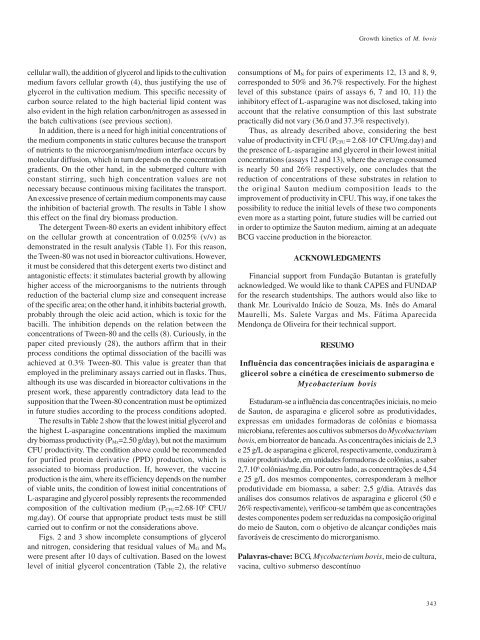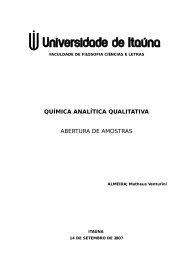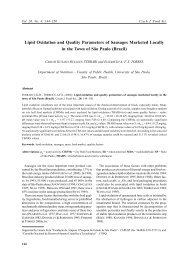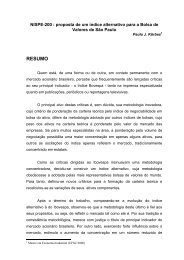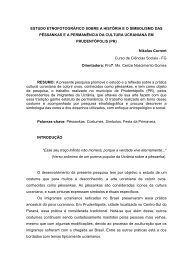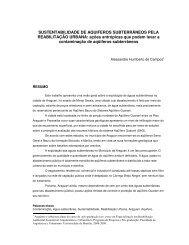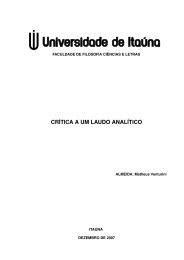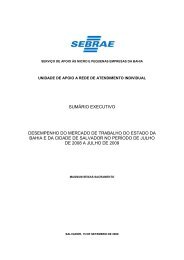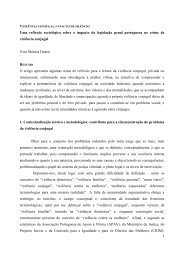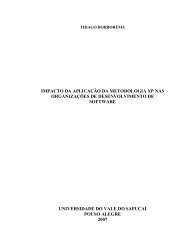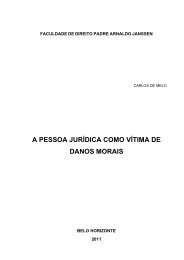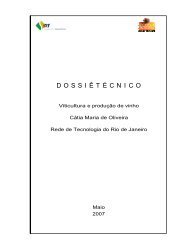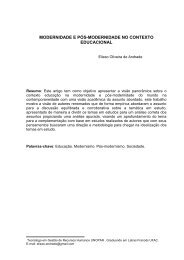MAL 007
MAL 007
MAL 007
Create successful ePaper yourself
Turn your PDF publications into a flip-book with our unique Google optimized e-Paper software.
cellular wall), the addition of glycerol and lipids to the cultivation<br />
medium favors cellular growth (4), thus justifying the use of<br />
glycerol in the cultivation medium. This specific necessity of<br />
carbon source related to the high bacterial lipid content was<br />
also evident in the high relation carbon/nitrogen as assessed in<br />
the batch cultivations (see previous section).<br />
In addition, there is a need for high initial concentrations of<br />
the medium components in static cultures because the transport<br />
of nutrients to the microorganism/medium interface occurs by<br />
molecular diffusion, which in turn depends on the concentration<br />
gradients. On the other hand, in the submerged culture with<br />
constant stirring, such high concentration values are not<br />
necessary because continuous mixing facilitates the transport.<br />
An excessive presence of certain medium components may cause<br />
the inhibition of bacterial growth. The results in Table 1 show<br />
this effect on the final dry biomass production.<br />
The detergent Tween-80 exerts an evident inhibitory effect<br />
on the cellular growth at concentration of 0.025% (v/v) as<br />
demonstrated in the result analysis (Table 1). For this reason,<br />
the Tween-80 was not used in bioreactor cultivations. However,<br />
it must be considered that this detergent exerts two distinct and<br />
antagonistic effects: it stimulates bacterial growth by allowing<br />
higher access of the microorganisms to the nutrients through<br />
reduction of the bacterial clump size and consequent increase<br />
of the specific area; on the other hand, it inhibits bacterial growth,<br />
probably through the oleic acid action, which is toxic for the<br />
bacilli. The inhibition depends on the relation between the<br />
concentrations of Tween-80 and the cells (8). Curiously, in the<br />
paper cited previously (28), the authors affirm that in their<br />
process conditions the optimal dissociation of the bacilli was<br />
achieved at 0.3% Tween-80. This value is greater than that<br />
employed in the preliminary assays carried out in flasks. Thus,<br />
although its use was discarded in bioreactor cultivations in the<br />
present work, these apparently contradictory data lead to the<br />
supposition that the Tween-80 concentration must be optimized<br />
in future studies according to the process conditions adopted.<br />
The results in Table 2 show that the lowest initial glycerol and<br />
the highest L-asparagine concentrations implied the maximum<br />
dry biomass productivity (PMx=2.50 g/day), but not the maximum<br />
CFU productivity. The condition above could be recommended<br />
for purified protein derivative (PPD) production, which is<br />
associated to biomass production. If, however, the vaccine<br />
production is the aim, where its efficiency depends on the number<br />
of viable units, the condition of lowest initial concentrations of<br />
L-asparagine and glycerol possibly represents the recommended<br />
composition of the cultivation medium (PCFU=2.68⋅10 6 CFU/<br />
mg.day). Of course that appropriate product tests must be still<br />
carried out to confirm or not the considerations above.<br />
Figs. 2 and 3 show incomplete consumptions of glycerol<br />
and nitrogen, considering that residual values of MG and MN<br />
were present after 10 days of cultivation. Based on the lowest<br />
level of initial glycerol concentration (Table 2), the relative<br />
Growth kinetics of M. bovis<br />
consumptions of MN for pairs of experiments 12, 13 and 8, 9,<br />
corresponded to 50% and 36.7% respectively. For the highest<br />
level of this substance (pairs of assays 6, 7 and 10, 11) the<br />
inhibitory effect of L-asparagine was not disclosed, taking into<br />
account that the relative consumption of this last substrate<br />
practically did not vary (36.0 and 37.3% respectively).<br />
Thus, as already described above, considering the best<br />
value of productivity in CFU (PCFU = 2.68⋅10 6 CFU/mg.day) and<br />
the presence of L-asparagine and glycerol in their lowest initial<br />
concentrations (assays 12 and 13), where the average consumed<br />
is nearly 50 and 26% respectively, one concludes that the<br />
reduction of concentrations of these substrates in relation to<br />
the original Sauton medium composition leads to the<br />
improvement of productivity in CFU. This way, if one takes the<br />
possibility to reduce the initial levels of these two components<br />
even more as a starting point, future studies will be carried out<br />
in order to optimize the Sauton medium, aiming at an adequate<br />
BCG vaccine production in the bioreactor.<br />
ACKNOWLEDGMENTS<br />
Financial support from Fundação Butantan is gratefully<br />
acknowledged. We would like to thank CAPES and FUNDAP<br />
for the research studentships. The authors would also like to<br />
thank Mr. Lourivaldo Inácio de Souza, Ms. Inês do Amaral<br />
Maurelli, Ms. Salete Vargas and Ms. Fátima Aparecida<br />
Mendonça de Oliveira for their technical support.<br />
RESUMO<br />
Influência das concentrações iniciais de asparagina e<br />
glicerol sobre a cinética de crescimento submerso de<br />
Mycobacterium bovis<br />
Estudaram-se a influência das concentrações iniciais, no meio<br />
de Sauton, de asparagina e glicerol sobre as produtividades,<br />
expressas em unidades formadoras de colônias e biomassa<br />
microbiana, referentes aos cultivos submersos do Mycobacterium<br />
bovis, em biorreator de bancada. As concentrações iniciais de 2,3<br />
e 25 g/L de asparagina e glicerol, respectivamente, conduziram à<br />
maior produtividade, em unidades formadoras de colônias, a saber<br />
2,7.10 6 colônias/mg.dia. Por outro lado, as concentrações de 4,54<br />
e 25 g/L dos mesmos componentes, corresponderam à melhor<br />
produtividade em biomassa, a saber: 2,5 g/dia. Através das<br />
análises dos consumos relativos de asparagina e glicerol (50 e<br />
26% respectivamente), verificou-se também que as concentrações<br />
destes componentes podem ser reduzidas na composição original<br />
do meio de Sauton, com o objetivo de alcançar condições mais<br />
favoráveis de crescimento do microrganismo.<br />
Palavras-chave: BCG, Mycobacterium bovis, meio de cultura,<br />
vacina, cultivo submerso descontínuo<br />
343


